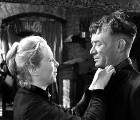What was the Bible world like?
Sacred Prostitution

‘Tamar’, stained glass window
by Diane-Blair Goodpasture
Many Bible readers are shocked by the fact that Tamar offered herself as a prostitute to Judah, and that Judah used her in this way.
Some have offered an alternative explanation, saying that she acted not as a common street-walker but as a sacred prostitute.
What was sacred prostitution? It was part of Canaanite religious practice, and the Canaanites were the power group at the time of Tamar and Judah – they owned the land through which Judah and his family travelled.
The Canaanites saw sexuality, either human or in Nature, as a divine force.
The ritual of sacred prostitution
According to Herodotus, a Greek historian writing in about 450BC, a Babylonian woman would undertake the following ritual:
- she would disguise herself at least once during her life, covering her face with a veil. In this way she discarded her own personal identity.
- She would then go to the temple and receive a man who was a stranger to her (Herodotus 1.199). This man, in this particular act, represented the incarnate god.
- Their sexual act was meant, by what is called ‘sympathetic magic’, to reflect and encourage fertility in the Great Mother, Nature.
- Herodotus emphasized that, once a woman had fulfilled this obligation, she was virtuous and loyal to her husband for the rest of her life.
This of course was in Babylon, not Canaan, but the Canaanites seem to have had a similar practice.
What was the Levirate Law?

The laws of Hammurabi carved on this stone stele had specific instructions for the protection of women; the biblical story of Tamar and Judah gave the same sort of instructions, but coded into a story form
The Law of Moses ruled that when brothers lived together in a clan and one of them died leaving a widow but no children, the woman had to marry one of his surviving brothers.
The purpose of this law was
- to provide for the widow,
- to carry on the name of the dead husband,
- and to keep family property intact.
The father of the dead man had the responsibility of seeing that this was carried out. He had to marry his second son to the widow, and see that she was given the rights and privileges of a wife within the tribe.
Judah flouts Levirate Law
Judah did not do this. He married Tamar to Onan, his second son, but he did not prevent Onan practising contraception.
There may have been any number of reasons for this, but the fact remained that Tamar was not given the opportunity of bearing a son who would inherit his father’s property.
Instead, Onan would receive his older brother’s share of the family possessions.
According to the Levirate Law, when Onan died Judah should have married Tamar to Shelah, his third son. He did not, and Tamar’s story, told over and over by the Hebrew tribespeople, emphasised the legal rights of widowed women.
Women in the early biblical period
It was probably in this period that women enjoyed greatest freedom and prestige. Stories in Genesis and Exodus show them as independent, strong, smart and tough. They displayed leadership and initiative.
The women almost always got their way when they wanted something. Tamar is a case in point: she knows her rights, and she pursues them decisively.

Middle Eastern woman
sifting grain
This was probably because women were necessary for the survival of the tribe, and they knew it.
Why were women so valued in the tribe?
Women did a wide range of tasks, without which the clan or family simply could not have managed.
They moved freely in society, and were not confined within the home. The Bible stories show that they spoke and acted confidently.
Their contribution to the culture of the time was significant. The stories as we have them in the Bible were edited much later by male priests, but there are hints that women had a thriving cultural tradition of their own – most of which was unfortunately lost because it was never recorded, as men’s stories were.
These stories dealt with women who were famous at the time, with families, children, food supplies, security/safety and home-places.
Some scholars suggest that many of the stories of Genesis were originally women’s stories, preserved by women in the clan and later written down by the male scribes.
Women and religion
Ordinary people used rituals to solve problems in their lives. They were anxious if it did not rain or if it rained too much; they were afraid of sickness and death. Every country had different rituals and religious practices to keep bad luck at bay and coax Nature into helping, not harming, humanity.
As well, women played an active role in religious matters. The concept of monotheism was just beginning to develop, but many women probably worshipped a fertility goddess, the Great Mother, source of plant, animal and human life.
Religion linked to fertility
Ancient Near Eastern religions certainly had fertility of the soil and animal life as one of their main focuses, with priestesses who served the forces of Nature – the power of river and rain water, abundance of crops and animals, etc.
The laws of Hammurabi, a famous law-maker and king of Babylonia, provide insights into the lives of women in this period. There were laws to
- protect the rights of women in marriage

Ancient seal
with imprint in clay - protect women against rape
- define the punishment for adultery
- define the just treatment of women who were slaves
- regulate the behaviour of sacred women who served in the temples
- lay down conditions for divorce, etc.
For more information on the lives of women in the Bible, see the links to
Family, work and religion: the tribe, the family, slaves, women’s tasks, beliefs
Milestones in a woman’s life: Puberty, menstruation, marriage, childbirth, death, burials

The original gates of the ancient city of Dan, excavated and preserved. Tamar stood waiting for Judah at gates like these

This small piece of ivory, dug up in the ancient city of Nimrud, shows the ‘woman at the window’. It was an important symbol in ancient fertility religions, but the meaning and story behind it has been lost. There are echoes of this image in the story of the mother of Sisera; she stands waiting for her son at a window of the palace, not knowing that he has already been murdered by Jael.
See the story of Deborah and Jael in Judges 4.
Search Box
![]()
Tamar links

Films often tell a story like Tamar’s, where the heroine has to adapt to an unwelcome situation. In ‘Hobson’s Choice’ an enterprising young woman makes the best of a bad situation, and ends up happy and in love.
* Make a list of movies with similar themes.
The sexually charged moment when Tamar meets Judah: famous paintings of this and other scenes
© Copyright 2006
Elizabeth Fletcher









